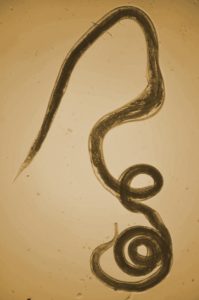Within the UK the most economically important cattle roundworms are Ostertagia ostertagi and Cooperia oncophora. Infection with these gutworms causes Parasitic Gastroenteritis (PGE), the main impact of which is suboptimal production as a consequence of reduced feed intake and nutrient absorption. PGE is most common in first-grazing season stock, as they are potentially ingesting large numbers of over-wintered larvae but have not yet developed immunity.
Lungworm (Dictyocaulus viviparus), causes parasitic bronchitis commonly known as ‘husk’ or ‘hoose’. The life cycle is similar to that of gutworms except that larvae rather than eggs are passed out in the faeces. Heavy stocking densities and wet mild summers can increase the risk of pastures being contaminated with large numbers of infective larvae. Lungworm typically infects young cattle during their first grazing season.
